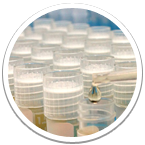Processing and storage of samples
THL Biobank stores samples and related information usually for long periods of time for purposes of future biobank research. Research into factors affecting health often requires extensive sets of research data as well as follow-up periods that can extend to several decades.
THL Biobank will contain human biological samples only, including tissue, blood, body fluids or DNA extracted from cells. THL Biobank will also store different kinds of information associated with the samples, including information about the sample donors' health state and lifestyles. Such information may have been requested from the sample donor at the time of the donation.
THL Biobank stores:
- biological samples (i.e. blood samples, DNA, cells)
- information obtained directly from the donor (i.e. lifestyle, diet, health status)
- measurements of the donor (i.e. blood pressure, height)
- test results (i.e. cholesterol, genetic analyses)
Biological samples are processed in a variety of ways in the biobank.
- Serum or plasma is extracted from blood samples to determine, for example, lipid content, inflammatory marker levels, and glucose and insulin levels.
- DNA is extracted from blood samples for purposes of genetic testing.
- Messenger RNA and proteins can be extracted from blood samples and other tissue samples to determine cell functions.
- Blood and tissue samples can also be used to cultivate cell lines for use in functional analyses and as additional sources of DNA and RNA.
Data protection is taken seriously in biobanks, and researchers do not use biobank samples and information in any way that could endanger the confidentiality of donors' privacy and health information. All samples are given a code, and no individual researcher will be able to identify the donor.




